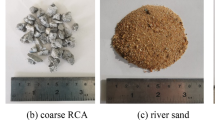Abstract
Providing geosynthetic-encased stone columns is a commonly adopted technique to improve the load-carrying capacity and reduce settlements in weak fills. Addressing the geo-environmental aspect, two different waste materials, i.e., fly ash and concrete debris, have been used for the sustainable environmental management. This paper presents a series of model tests results carried on single unencased and geosynthetic-encased construction concrete debris (CCD) column installed in fly ash fill under short-term loading. Footing size was taken as twice the column diameter for 25% area replacement ratio. Two sizes of columns, 50 mm and 75 mm diameter, have been used for both end-bearing and floating end conditions. The results were analyzed in terms of bearing capacity ratio and settlement ratio. Experimental model tests clearly show that circumferential geosynthetic encasement greatly influences the ultimate load-carrying capacity of CCD column and reduces settlement of treated fly ash fill bed.











Similar content being viewed by others
Abbreviations
- BCR:
-
Bearing capacity ratio
- CCD:
-
Construction concrete debris
- D:
-
Diameter of the column
- EB:
-
End-bearing column
- F:
-
Floating column
- FAF:
-
Fly ash fill
- FOS:
-
Factor of safety
- GESC:
-
Geosynthetic-encased stone column
- l :
-
Length of encasement
- L:
-
Length of the CCD column
- OSC:
-
Ordinary stone column (un-encased)
- S R :
-
Settlement ratio
References
Report on fly ash generation at coal/lignite based thermal Power stations and its utilization in the country for the year 2016–17. Central Electricity Authority, New Delhi, December 2017. http://www.cea.nic.in/reports/others/thermal/tcd/flyash_201617.pdf
Joshi RC, Dunkan DM, McMaster HM (1975) New and conventional engineering uses of fly ash. J Transp Eng ASCE 101(TE 4):791–806
Kaniraj SR, Havanagi VG (1999) Geotechnical characteristics of fly ash-soil mixtures. Geotech Eng J 30(2):129–147
Dayal U, Sinha R (1999) Design construction and monitoring of ash dyke. In: Fly ash disposal and deposition: beyond 200 AD. Norosa Publishing House, New Delhi. Article number 1
Das SK, Yudhbir (2005) Geotechnical characterization of some Indian fly ashes. J Mater Civ Eng ASCE 17(5):544. https://doi.org/10.1061/(ASCE)0899-1561(2005)17:5(544)
Pal SK, Ghosh A (2009) Shear strength behavior of Indian fly ashes. IGC, Guntur
Saravanan, Priya S (2013) Study on Sintered flyash-aggregate as columnar inclusions in soft clay. Int J Eng Technol Res 1(1):38–44
Isaac DS, Girish MS (2009) Suitability of different materials for stone column construction. EJGE 14:2–12
Kumar A, Sadana D (2012) Bearing capacity of soil reinforced with vertical columns of recycled concrete aggregates. Aust J Civ Eng 10(2):153–161
Agnihotri AK, Kumar V, Gupta D (2013) Use of construction concrete debris as vertical stone column. In: Indian geotechnical conference, December 22–24, Roorkee
Afshar JN, Ghazavi M (2014) Experimental studies on bearing capacity of geosynthetic reinforced stone columns. Arab J Sci Eng 39:1559–1571
Murugesan S, Rajagopal K (2006) Geosynthetic-encased stone columns: numerical evaluation. Geotext Geomembr 24:349–358
Murugesan S, Rajagopal K (2007) Model tests on geosynthetic encased stone column. Geosynth Int 14:346–358
Murugesan S, Rajagopal K (2010) Studies on the behavior of single and group of geosynthetic encased stone columns. J Geotech Geoenviron Eng ASCE 136(1):129–139
Ambily AP, Gandhi SR (2007) Behavior of stone columns based on experimental and FEM analysis. J Geotech Geoenviorn Eng ASCE 133:405–415
Gniel J, Bouazza A (2009) Improvement of soft soil using geo-grid encased stone columns. Geotext Geomembr 27:167–175
Deb K, Samadhiya NK, Namdeo JB (2011) Laboratory model studies on unreinforced and geo-grid reinforced sand bed over stone column-improved soft clay. Geotext Geomembr 29:190–196
Basu P, Samadhiya NK (2013) Load-Settlement characteristics of circumferentially reinforced granular pile. In: Proceedings of Indian geotechnical conference, December 22–24, Roorkee
Hasan M, Samadhiya NK (2016) 3D numerical analysis of granular piles with internal horizontal geo-grid strips in layers. In: Indian geotechnical conference IGC 2016, 15–17 December, IIT Madras, Chennai
Hasan M, Samadhiya NK (2016) Experimental and numerical analysis of geosynthetic-reinforced floating granular piles soft clays. Int J Geosynth Ground Eng 2:22
Ali K, Shahu JT, Sharma KG (2012) Model tests on geosynthetic-reinforced stone columns: a comparative study. Geosynth Int 19(4):292–305
Dash SK, Bora MC (2013) Influence of geosynthetic encasement on the performance of stone columns floating in soft clay. Can Geotech J 50:754–765
Barksdale RD, Bachus RC (1983) Design and Construction of stone column-volume 1-final report, FHWA/RD-83/026. U.S. Department of Transportation, Federal Highway Administration
Indian Standard (IS), 383 (1970) Indian standard code for specification for coarse and fine aggregates from natural source for concrete (second revision), New Delhi, India
Indian Standards (IS) (2003) Indian standard code of practice for design and construction of ground improvement guidelines (Part 1): stone columns IS: 15284 (Part1), New Delhi, India
Author information
Authors and Affiliations
Corresponding author
Rights and permissions
About this article
Cite this article
Bhatia, R., Kumar, A. Model tests on geosynthetic-encased construction concrete debris column in fly ash fill. Innov. Infrastruct. Solut. 4, 31 (2019). https://doi.org/10.1007/s41062-019-0217-0
Received:
Accepted:
Published:
DOI: https://doi.org/10.1007/s41062-019-0217-0




